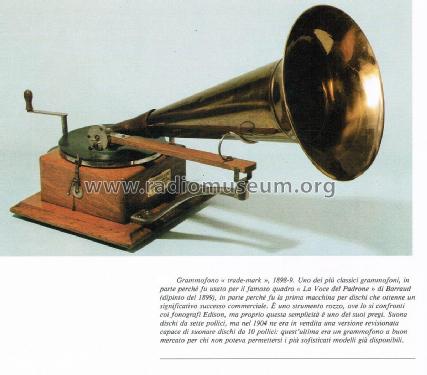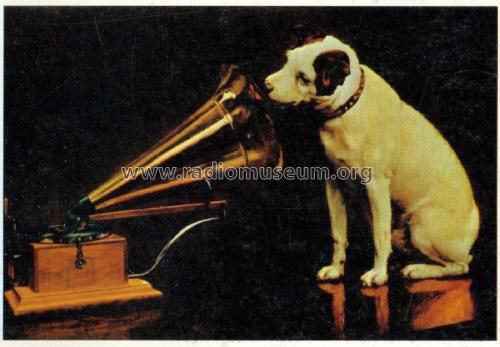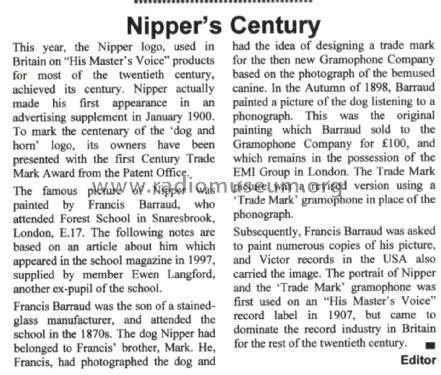Gramophone Trade-Mark
Gramophone Company Ltd., Gramophone & Typewriter Co. Ltd.; London
- Produttore / Marca
- Gramophone Company Ltd., Gramophone & Typewriter Co. Ltd.; London
- Anno
- 1902 ?
- Categoria
- Grammofono o fonografo meccanico
- Radiomuseum.org ID
- 355111
- Gamme d'onda
- - senza
- Particolarità
- Giradischi (non cambiadischi)
- Tensioni di funzionamento
- Energia solare e/o a carica manuale, anche se con presa di alimentazione
- Altoparlante
- Tromba
- Materiali
- Mobile in legno
- Radiomuseum.org
- Modello: Gramophone Trade-Mark - Gramophone Company Ltd.,
- Forma
- Soprammobile basso, con andamento orizzontale (grosse dimensioni).
- Annotazioni
-
Trade-Mark gramophone. One of the most classic gramophones, partly because it was used for the famous painting His Master's Voice by Barraud (painted in 1899), and partly because it was the first record machine that achieved significant commercial success. It is a crude instrument when compared to Edison phonographs, but this very simplicity is one of its advantages. It plays 7-inch records, but in 1904 a revised version capable of playing 10-inch records was on sale: the latter was a cheap gramophone for those who could not afford the more sophisticated models already available. Fonografi e Grammofoni by Christopher Proudfoot, Italian edition “Silvana Editoriale” 1980.
Nipper Painting History
The Nipper logo, used in Britain on His Master’s Voice products for most of the twentieth century, achieved its century. Nipper actually made his first appearance in an advertising supplement in January 1900. To mark the centenary of the ‘dog and horn’ logo, its owners have been presented with the first Century Trade Mark Award from the Patent Office.
The famous picture of Nipper was painted by Francis Barraud, who attended Forest School in Snaresbrook, London, E.17. The following notes are based on an article about him which appeared in the school magazine in 1997, supplied by member Ewen Langford, another ex-pupil of the school.
Francis Barraud was the son of a stained glass manufacturer and attended the school in the 1870s. The dog Nipper had belonged to Francis’ brother, Mark. He, Francis, had photographed the dog and had the idea of designing a trademark for the then-new Gramophone Company based on the photograph of the bemused canine. In the Autumn of 1898, Barraud painted a picture of the dog listening to a phonograph. This was the original painting that Barraud sold to the Gramophone Company for £100, and which remains in the possession of the EMI Group in London. The Trade Mark picture was a revised version using a ‘Trade Mark’ gramophone in place of the phonograph.
Subsequently, Francis Barraud was asked to paint numerous copies of his picture, and Victor records in the USA also carried the image. The portrait of Nipper and the TradeMark gramophone was first used on “His Master’s Voice” record label in 1907, but came to dominate the record industry in Britain for the rest of the twentieth century.
Hillandale News, June 2000, Iss. 230, Page 65, The magazine of the City of London Phonograph and Gramophone Society.
Grammofono «Trade-Mark». Uno dei più classici grammofoni, in parte perchè fu usato per il famoso quadro «La Voce del Padrone» di Barraud (dipinto nel 1899), in parte perchè fu la prima macchina per dischi che ottenne un significativo successo commerciale. É uno strumento rozzo, ove lo si confronti con i fonografi Edison, ma proprio questa semplicità è uno dei suoi pregi. Suona dischi da 7 pollici, ma nel 1904 ne era in vendita una versione revisionata capace di suonare dischi da 10 pollici: quest'ultima era un grammofono a buon mercato per chi non poteva permettersi i più sofisticati modelli già disponibili.
Da: “Fonografi e Grammofoni” di Christopher Proudfoot. Edizione Italiana Silvana Editoriale, 1980.
- Bibliografia
- -- Original prospect or advert (“Fonografi e Grammofoni” by Christopher Proudfoot, Italian edition “Silvana Editoriale” 1980.)
- Letteratura / Schemi (1)
- -- Original-techn. papers. (Hillandale News, June 2000, Iss. 230, Page 65)
- Autore
- Modello inviato da Pier Antonio Aluffi. Utilizzare "Proponi modifica" per inviare ulteriori dati.
- Altri modelli
-
In questo link sono elencati 19 modelli, di cui 19 con immagini e 0 con schemi.
Elenco delle radio e altri apparecchi della Gramophone Company Ltd., Gramophone & Typewriter Co. Ltd.; London


